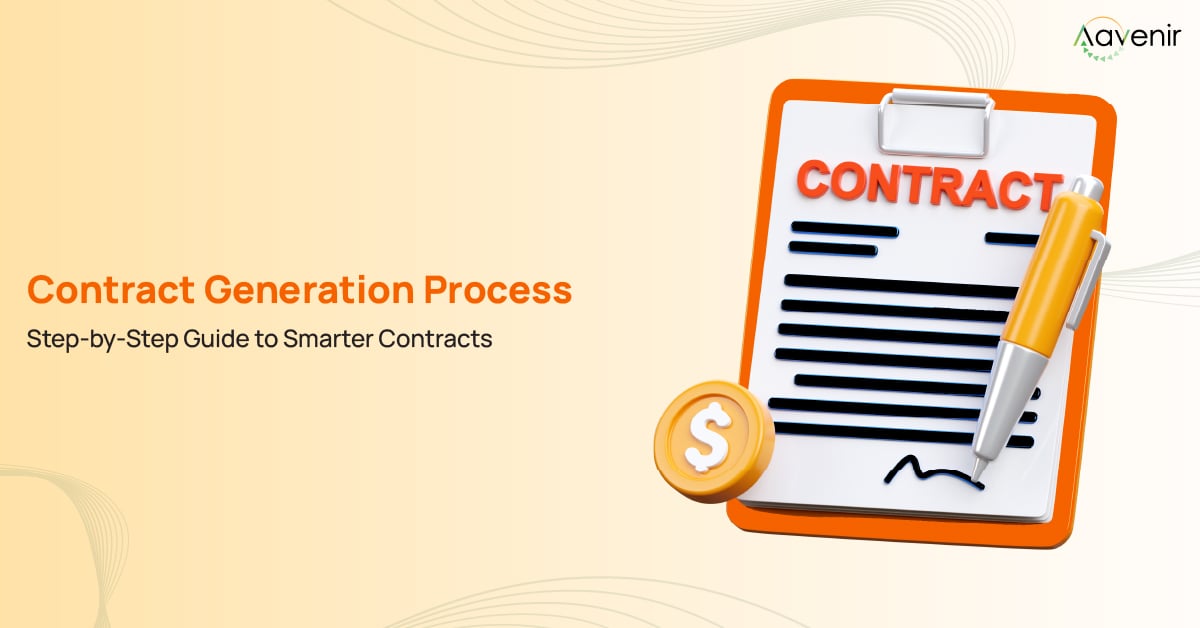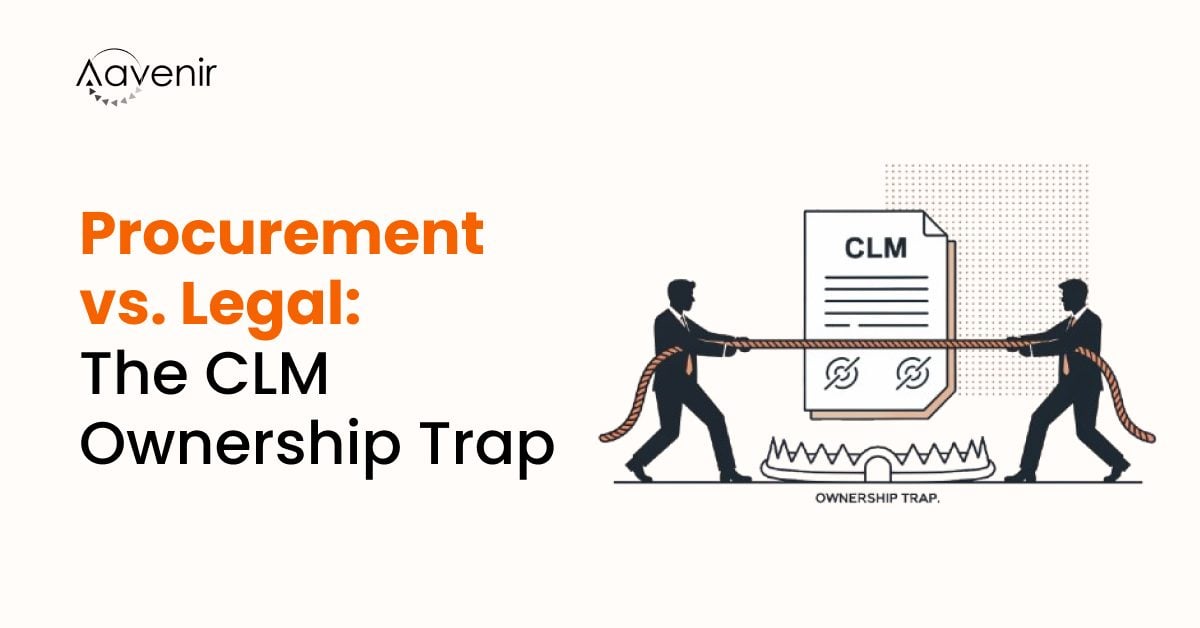Imagine this scenario: a procurement manager at a Fortune 500 manufacturing company receives an urgent request for a supplier contract on a Friday afternoon. The deal needs to close by Monday to meet a critical production deadline.
Under the traditional approach, Sarah would spend her weekend manually drafting the contract, cross-referencing legal templates, and coordinating with multiple stakeholders across different time zones. By Monday morning, she’d have a contract—but likely with inconsistencies, missing clauses, and potential compliance gaps that could cost her company millions.
This story plays out thousands of times daily across enterprises worldwide. The contract generation process has become a critical bottleneck that either accelerates business growth or creates costly delays. In today’s fast-paced business environment, organizations can no longer afford inefficient contract creation and drafting workflows that drain resources and introduce unnecessary risks.
The contract generation process encompasses the entire journey from initial template creation to final execution, integrating contract creation strategies with sophisticated drafting methodologies. Companies that master this process don’t just save time—they gain competitive advantages through faster deal closure, reduced legal risks, and improved stakeholder satisfaction.
Understanding the Contract Generation Process
The contract generation process is a comprehensive workflow that transforms business requirements into legally binding agreements through systematic creation, drafting, and approval stages. While often used interchangeably, contract generation, contract creation, and contract drafting represent distinct but interconnected phases of the overall workflow.
Contract creation forms the foundation, involving the initial setup of templates, clause libraries, and standardized frameworks that ensure consistency across all agreements. Contract drafting represents the customization phase, where specific terms, conditions, and negotiation points are incorporated into the base template. The broader contract generation process orchestrates these elements into a seamless workflow that produces compliant, accurate, and business-ready contracts.
Multiple stakeholders participate in this process, each bringing unique perspectives and requirements. Legal teams ensure compliance and risk mitigation, procurement professionals focus on supplier relationships and commercial terms, sales teams prioritize deal velocity and customer satisfaction, and finance departments scrutinize payment terms and revenue recognition implications. The complexity of coordinating these diverse stakeholders often determines whether the contract generation process becomes a competitive advantage or an operational burden.
Accelerate Contract Generation with Aavenir Contractflow
Create contracts in minutes—not days—with Aavenir Contractflow. Automate contract generation using smart templates, clause libraries, and seamless integrations.
Stages of the Contract Generation Process
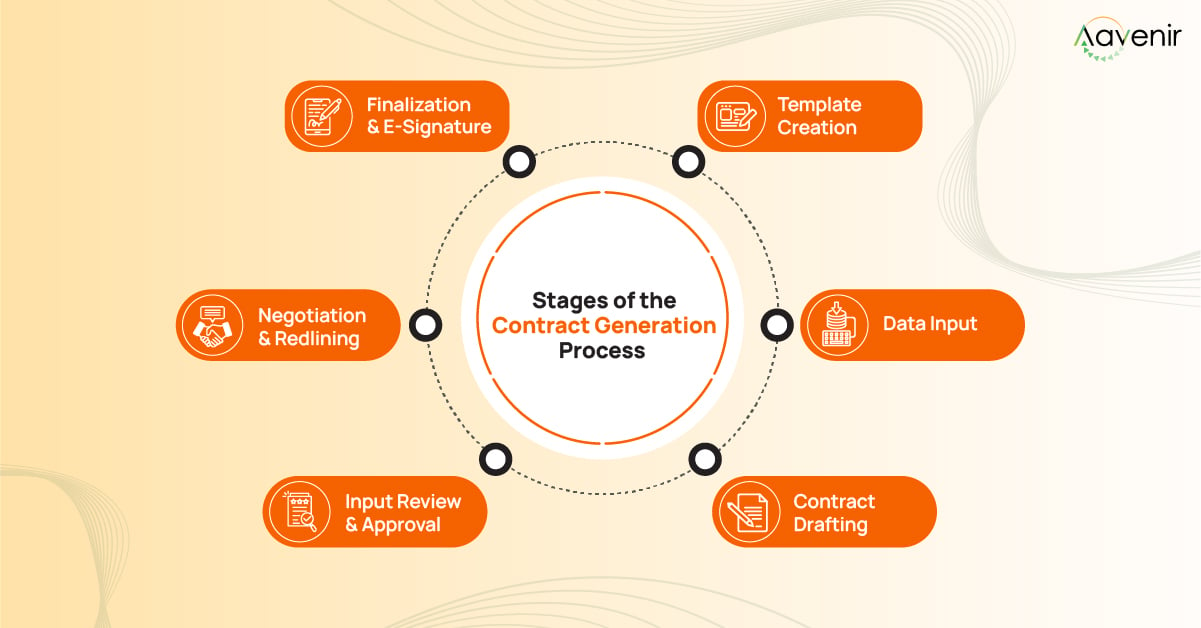
Template Creation: The Foundation of Contract Creation
Effective contract generation begins with robust template creation that standardizes language, structure, and compliance requirements across all agreement types. This phase involves legal experts collaborating with business stakeholders to develop master templates that capture organizational policies, regulatory requirements, and industry best practices.
Template creation extends beyond simple document formatting to include dynamic field mapping, conditional logic, and approval workflows that adapt to different contract scenarios. Organizations with mature contract creation processes maintain comprehensive clause libraries with pre-approved language for common terms like limitation of liability, intellectual property rights, and termination conditions. These libraries enable rapid contract assembly while ensuring legal consistency and risk mitigation.
Data Input: Bridging Manual and Dynamic Fields
The data input stage transforms static templates into customized agreements through the integration of specific business information. Traditional approaches rely heavily on manual data entry, creating opportunities for errors and inconsistencies that can derail negotiations or create compliance gaps.
Modern contract generation processes leverage integration capabilities with existing business systems like Customer Relationship Management (CRM) platforms, Enterprise Resource Planning (ERP) systems, and procurement databases. This integration automatically populates contract fields with accurate, real-time information including party details, pricing structures, delivery schedules, and performance metrics. The result is dramatically reduced manual effort and significantly improved data accuracy.
Contract Drafting: Customization and Negotiation Preparation
Contract drafting represents the customization phase where standardized templates are adapted to specific business relationships and transaction requirements. This stage requires careful balance between maintaining organizational standards and accommodating counterparty needs and market conditions.
Effective contract drafting incorporates lessons learned from previous negotiations, industry benchmarks, and regulatory updates. Legal teams work closely with business stakeholders to identify potential negotiation points, develop fallback positions, and create alternative language options that facilitate productive discussions. Advanced drafting processes include collaboration tools that enable real-time editing, version control, and stakeholder feedback integration.
Internal Review and Approval
The internal review and approval stage ensures contracts meet organizational standards before external distribution. This phase involves multiple review cycles depending on contract value, risk profile, and strategic importance. Standard commercial agreements might require only procurement and legal approval, while high-value strategic partnerships could involve executive leadership, finance, and technical teams.
Efficient approval workflows incorporate automated routing based on predefined criteria, parallel review processes for non-conflicting elements, and escalation procedures for time-sensitive agreements. Organizations with mature contract generation processes maintain clear approval matrices that specify authority levels, review timelines, and exception handling procedures.
Negotiation and Redlining
The negotiation phase transforms draft agreements into mutually acceptable terms through structured discussions and document modifications. This stage often represents the most time-intensive aspect of contract generation, particularly for complex commercial relationships or novel transaction structures.
Effective negotiation management requires sophisticated collaboration tools that enable real-time document sharing, change tracking, and communication integration. Legal teams benefit from negotiation playbooks that provide guidance on acceptable terms, escalation triggers, and alternative language options. The ability to quickly assess the business impact of proposed changes often determines negotiation success and timeline adherence.
Finalization and E-Signature
The finalization stage converts negotiated agreements into executed contracts through formal signature processes. Traditional approaches involving printed documents, physical signatures, and mail delivery create unnecessary delays and administrative burdens that can jeopardize time-sensitive transactions.
Modern contract generation processes leverage electronic signature platforms that provide legally compliant execution capabilities while maintaining comprehensive audit trails. Integration between contract management systems and e-signature platforms enables automated document routing, signature reminders, and completion notifications that ensure timely execution without manual intervention.
Challenges in Traditional Contract Creation and Generation
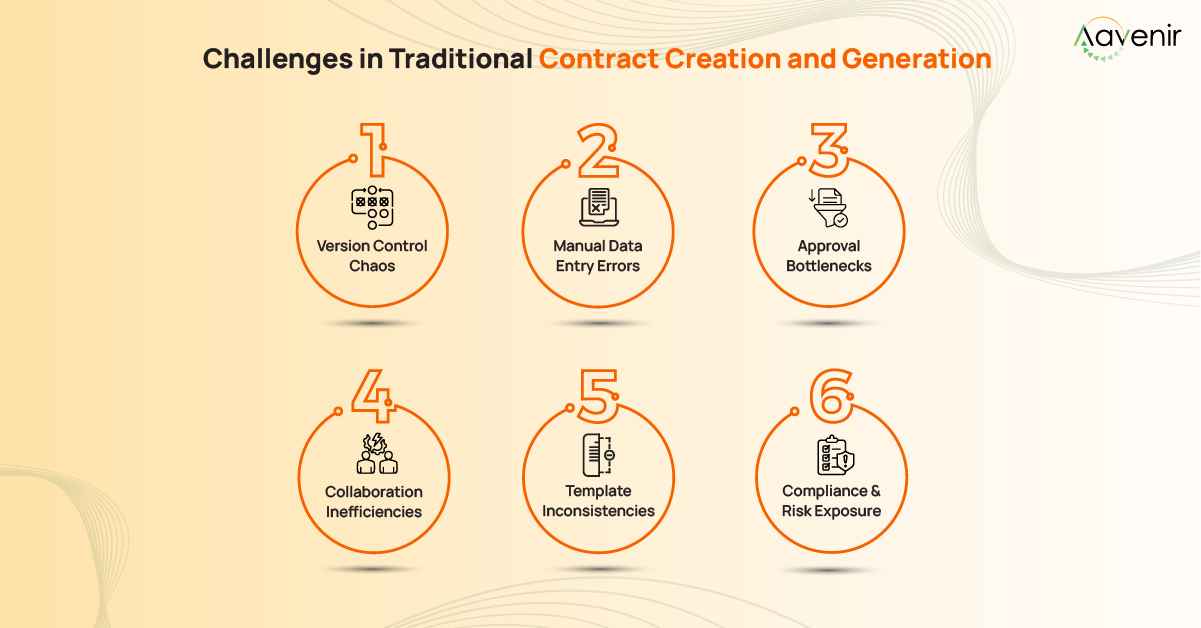
Traditional contract processes create numerous pain points that impact both contract creation efficiency and overall business performance:
- Version Control Chaos: Organizations relying on email-based collaboration face constant confusion about which document represents the current version, increasing the risk of executing outdated agreements and creating legal vulnerabilities.
- Manual Data Entry Errors: Repetitive data entry across multiple systems compounds inefficiencies, with studies showing that 60% of contract delays result from data entry errors and subsequent correction cycles that drain resources and delay deal closure.
- Sequential Approval Bottlenecks: When multiple stakeholders must review and approve contracts one after another rather than in parallel, delays multiply exponentially. Legal teams report spending up to 40% of their time on administrative tasks rather than strategic legal work.
- Collaboration Inefficiencies: Business teams experience significant frustration with lengthy approval cycles that directly impact deal closure rates, while lack of real-time collaboration tools creates communication gaps and project delays.
- Compliance and Risk Exposure: Organizations without centralized contract repositories and standardized approval workflows face exponentially increased compliance risks. Non-standard terms can create unexpected legal exposure, while missing compliance clauses can result in costly regulatory violations.
- Template Inconsistencies: Without proper template management, different departments often create their own versions of standard agreements, leading to inconsistent terms, varied risk levels, and potential conflicts between different contract versions.
How to Streamline the Contract Generation Process
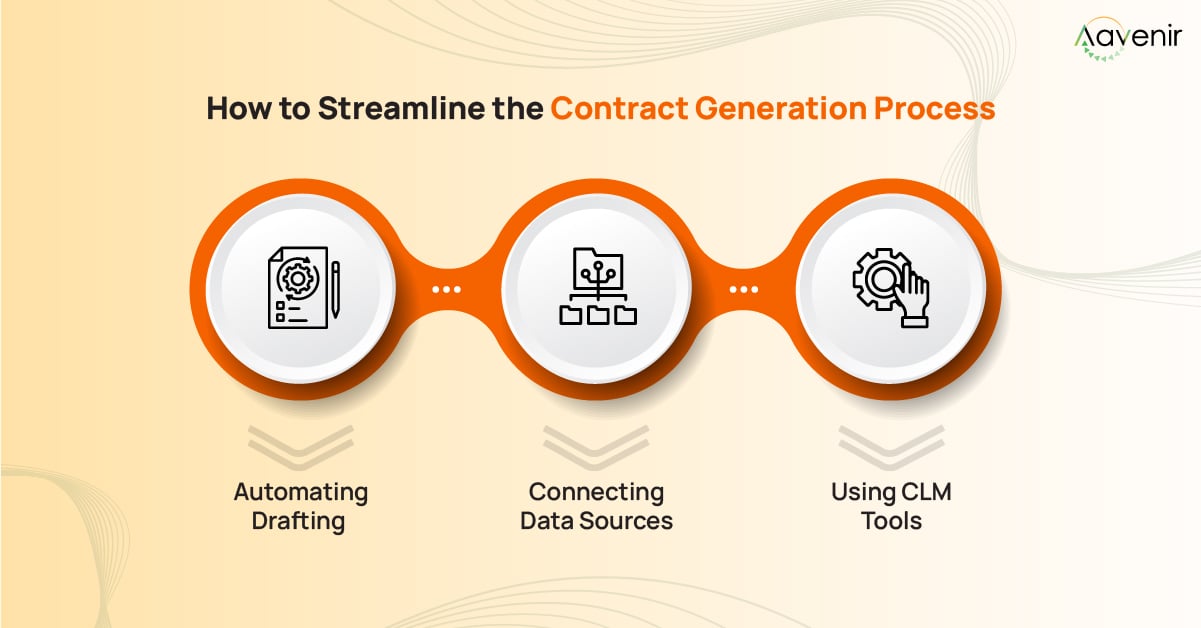
Automating Drafting with Templates and Clause Libraries
The foundation of streamlined contract generation lies in comprehensive automation of routine drafting tasks. Organizations should develop intelligent template systems that can automatically select appropriate clauses based on contract type, counterparty characteristics, and risk assessment parameters.
For example, a global consulting firm implemented a system that automatically includes specific data protection clauses for EU-based clients while applying different privacy provisions for US-based engagements. This automation ensures compliance consistency while reducing manual review requirements.
Connecting Data Sources for Seamless Integration
Modern contract generation platforms should integrate seamlessly with existing business systems to eliminate manual data entry. CRM integration enables automatic population of customer information, while ERP connections can populate pricing and service level details.
Consider implementing APIs that connect your contract generation platform with procurement systems, enabling automatic creation of vendor agreements when new suppliers are onboarded. This integration reduces processing time from weeks to hours while improving data accuracy.
Using CLM Tools for Unified Workflows
Comprehensive CLM platforms provide end-to-end contract lifecycle management that eliminates the need for multiple disconnected tools. These platforms should offer template management, automated workflows, collaboration capabilities, and integration with e-signature platforms.
Look for CLM solutions that provide configurable approval workflows, automated notifications, and real-time reporting on contract status and bottlenecks.
Top Benefits of Automating Contract Creation
Automating contract creation through streamlined generation processes delivers measurable benefits that directly impact organizational performance and competitive positioning. Below are the top five benefits:
1. Improved Accuracy
Improved accuracy represents the most immediate benefit, as automated systems eliminate common manual errors like incorrect pricing, inconsistent terms, and missing clauses that can result in costly disputes or renegotiation requirements. By using pre-approved templates and standardized clause libraries, organizations can ensure contracts are generated with consistency, reducing the risk of oversight and the downstream impact of human error.
2. Faster Turnaround Times
Faster turnaround times enable organizations to respond more quickly to market opportunities and customer requirements. Automated contract generation can reduce typical contract cycles from weeks to days or even hours, depending on complexity and approval requirements. This acceleration is particularly valuable in competitive bidding situations where rapid response capabilities can determine win rates, giving businesses a critical edge.
3. Reduced Legal Review Time
Reduced legal review time allows legal teams to focus on strategic, high-value activities rather than routine document assembly and error checking. Automated systems can identify potential issues, suggest appropriate language, and route contracts to appropriate reviewers based on risk profiles and complexity levels. This optimization improves legal team productivity while ensuring appropriate attention to critical contract elements, minimizing bottlenecks in the review process.
4. Enhanced Compliance and Audit-Readiness
Enhanced compliance and audit-readiness provide significant value in regulated industries or organizations with complex governance requirements. Automated systems maintain comprehensive audit trails, ensure consistent application of regulatory requirements, and provide real-time visibility into contract status and compliance metrics. This capability reduces regulatory risk while simplifying audit preparation and regulatory reporting requirements.
5. Cost Reduction Through Improved Efficiency
Cost reduction through improved efficiency extends beyond direct labor savings to include reduced errors, faster deal closure, and improved supplier relationships. Organizations implementing automated contract generation typically report 40–60% reductions in contract cycle times and 25–35% decreases in legal review requirements. These improvements translate directly to increased revenue velocity and reduced operational costs, reinforcing the business case for automation.
Tools That Support Contract Generation and Creation
The contract generation technology landscape includes specialized CLM platforms, document automation tools, and e-signature solutions that address different aspects of the overall workflow. Leading CLM platforms like Aavenir, Ironclad, and ContractWorks provide comprehensive contract lifecycle management capabilities that integrate generation, negotiation, execution, and ongoing management functions.
Switch to Aavenir Contractflow for 5X Better Visibility
Experience smarter, faster, compliant contracting with Aavenir Contractflow. Implement in hours and get started with contract intelligence.
AI- powered contract management platform like Aavenir exemplifies modern CLM capabilities with AI-powered contract generation, automated workflow routing, and integrated analytics that provide visibility into contract performance and compliance status. The platform’s template management system enables organizations to maintain standardized language while accommodating customization requirements, and its integration capabilities connect with existing business systems to eliminate manual data entry.
Document automation tools like Docupilot and PandaDoc focus specifically on contract creation and generation workflows, providing sophisticated template management, conditional logic, and data integration capabilities. These platforms excel at high-volume, standardized contract generation scenarios where consistency and speed are primary requirements.
E-signature platforms including DocuSign and Adobe Sign provide the final execution capability that transforms draft agreements into legally binding contracts. Modern e-signature solutions offer advanced authentication, comprehensive audit trails, and integration capabilities that connect seamlessly with CLM and document automation platforms.
The most effective contract generation implementations combine multiple tools into integrated workflows that address the entire contract lifecycle. Organizations should evaluate their specific requirements, existing technology infrastructure, and scalability needs when selecting contract generation tools and platforms.
Conclusion
The contract generation process has evolved from a necessary administrative function to a critical competitive differentiator that directly impacts business agility, risk management, and growth potential. Organizations that continue to rely on manual, fragmented approaches to contract creation and drafting are increasingly disadvantaged by longer cycle times, higher error rates, and reduced scalability.
Successful contract generation process optimization requires comprehensive evaluation of technology solutions, process redesign, and organizational change management. The benefits—improved accuracy, faster turnaround times, reduced legal burden, and enhanced compliance—justify the implementation investment while providing ongoing competitive advantages.
Modern businesses cannot afford to treat contract generation as an afterthought or accept the limitations of traditional approaches. The organizations that thrive in today’s competitive environment are those that leverage technology and process optimization to transform contract generation from a bottleneck into a strategic advantage.
Ready to transform your contract generation process? Discover how Aavenir’s comprehensive CLM platform can automate your contract creation workflows, reduce cycle times, and improve compliance across your organization. Schedule a personalized demo today to see how leading enterprises are revolutionizing their contract generation processes and achieving measurable business outcomes.
Frequently Asked Questions (FAQs)
1. What is contract generation?
Contract generation refers to the process of creating legally binding agreements using pre-defined templates, clause libraries, and dynamic data fields—often supported by automation tools or Contract Lifecycle Management (CLM) platforms. The goal is to produce accurate, consistent, and compliant contracts at scale, reducing the time and effort typically associated with manual drafting.
2. How is contract generation different from contract creation?
While often used interchangeably, there is a subtle difference:
1. Contract creation is the broader process that includes drafting, editing, reviewing, and finalizing contracts—whether manually or digitally.
2. Contract generation, on the other hand, specifically refers to the automated creation of contracts using predefined inputs like templates, rules, and data integrations.
In essence, contract generation is a subset of contract creation—focused on automating and accelerating the early drafting phase.
3. What tools help automate contract generation?
Several tools and platforms can automate contract generation, including:
1. CLM platforms (e.g., Aavenir Contractflow, Ironclad, Icertis): Provide end-to-end automation from generation to execution.
2. Document automation tools (e.g., Docupilot, PandaDoc): Focused on dynamic template-driven document creation.
3. CRM and ERP integrations: Auto-populate contract data from systems like Salesforce, SAP, or Oracle.
4. E-signature tools (e.g., DocuSign, Adobe Sign): Finalize contracts quickly with secure, compliant digital signatures.


